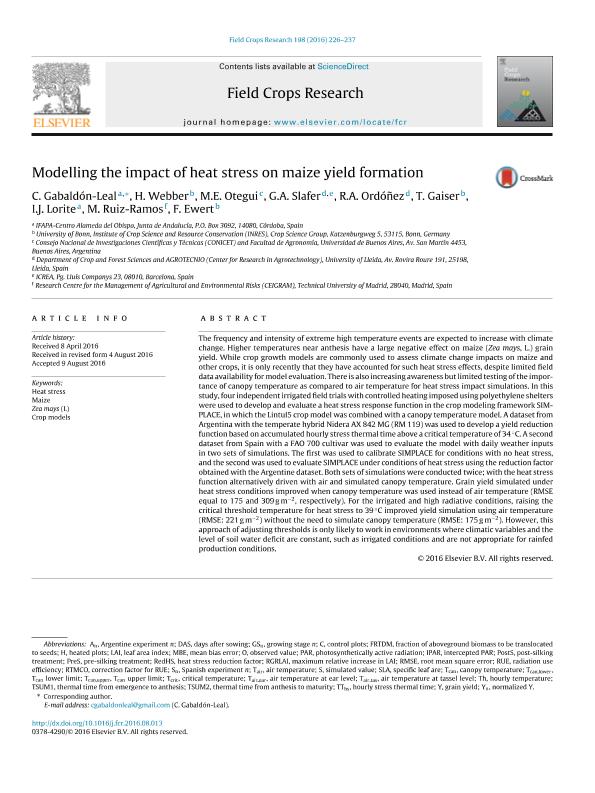Mostrar el registro sencillo del ítem
dc.contributor.author
Gabaldón Leal, C.
dc.contributor.author
Webber, H.
dc.contributor.author
Otegui, Maria Elena

dc.contributor.author
Slafer, Gustavo Ariel

dc.contributor.author
Ordóñez, R. A.
dc.contributor.author
Gaiser, T.
dc.contributor.author
Lorite, I. J.
dc.contributor.author
Ruiz Ramos, M.
dc.contributor.author
Ewert, F.
dc.date.available
2019-11-29T18:27:16Z
dc.date.issued
2016-11
dc.identifier.citation
Gabaldón Leal, C.; Webber, H.; Otegui, Maria Elena; Slafer, Gustavo Ariel; Ordóñez, R. A.; et al.; Modelling the impact of heat stress on maize yield formation; Elsevier Science; Field Crops Research; 198; 11-2016; 226-237
dc.identifier.issn
0378-4290
dc.identifier.uri
http://hdl.handle.net/11336/90962
dc.description.abstract
The frequency and intensity of extreme high temperature events are expected to increase with climate change. Higher temperatures near anthesis have a large negative effect on maize (Zea mays, L.) grain yield. While crop growth models are commonly used to assess climate change impacts on maize and other crops, it is only recently that they have accounted for such heat stress effects, despite limited field data availability for model evaluation. There is also increasing awareness but limited testing of the importance of canopy temperature as compared to air temperature for heat stress impact simulations. In this study, four independent irrigated field trials with controlled heating imposed using polyethylene shelters were used to develop and evaluate a heat stress response function in the crop modeling framework SIMPLACE, in which the Lintul5 crop model was combined with a canopy temperature model. A dataset from Argentina with the temperate hybrid Nidera AX 842 MG (RM 119) was used to develop a yield reduction function based on accumulated hourly stress thermal time above a critical temperature of 34 °C. A second dataset from Spain with a FAO 700 cultivar was used to evaluate the model with daily weather inputs in two sets of simulations. The first was used to calibrate SIMPLACE for conditions with no heat stress, and the second was used to evaluate SIMPLACE under conditions of heat stress using the reduction factor obtained with the Argentine dataset. Both sets of simulations were conducted twice; with the heat stress function alternatively driven with air and simulated canopy temperature. Grain yield simulated under heat stress conditions improved when canopy temperature was used instead of air temperature (RMSE equal to 175 and 309 g m−2, respectively). For the irrigated and high radiative conditions, raising the critical threshold temperature for heat stress to 39 °C improved yield simulation using air temperature (RMSE: 221 g m−2) without the need to simulate canopy temperature (RMSE: 175 g m−2). However, this approach of adjusting thresholds is only likely to work in environments where climatic variables and the level of soil water deficit are constant, such as irrigated conditions and are not appropriate for rainfed production conditions.
dc.format
application/pdf
dc.language.iso
eng
dc.publisher
Elsevier Science

dc.rights
info:eu-repo/semantics/openAccess
dc.rights.uri
https://creativecommons.org/licenses/by-nc-sa/2.5/ar/
dc.subject
CROP MODELS
dc.subject
HEAT STRESS
dc.subject
MAIZE
dc.subject
ZEA MAYS (L)
dc.subject.classification
Agricultura

dc.subject.classification
Agricultura, Silvicultura y Pesca

dc.subject.classification
CIENCIAS AGRÍCOLAS

dc.title
Modelling the impact of heat stress on maize yield formation
dc.type
info:eu-repo/semantics/article
dc.type
info:ar-repo/semantics/artículo
dc.type
info:eu-repo/semantics/publishedVersion
dc.date.updated
2019-11-21T17:36:30Z
dc.journal.volume
198
dc.journal.pagination
226-237
dc.journal.pais
Países Bajos

dc.journal.ciudad
Amsterdam
dc.description.fil
Fil: Gabaldón Leal, C.. Centro Alameda del Obispo; España
dc.description.fil
Fil: Webber, H.. Universitat Bonn; Alemania
dc.description.fil
Fil: Otegui, Maria Elena. Consejo Nacional de Investigaciones Científicas y Técnicas; Argentina. Universidad de Buenos Aires. Facultad de Agronomía. Departamento de Producción Vegetal. Cátedra de Producción Vegetal; Argentina
dc.description.fil
Fil: Slafer, Gustavo Ariel. Universidad de Lleida; España. Consejo Nacional de Investigaciones Científicas y Técnicas; Argentina. Institució Catalana de Recerca i Estudis Avancats; España
dc.description.fil
Fil: Ordóñez, R. A.. Universidad de Lleida; España
dc.description.fil
Fil: Gaiser, T.. Universitat Bonn; Alemania
dc.description.fil
Fil: Lorite, I. J.. Centro Alameda del Obispo; España
dc.description.fil
Fil: Ruiz Ramos, M.. Universidad Politécnica de Madrid; España
dc.description.fil
Fil: Ewert, F.. Universitat Bonn; Alemania
dc.journal.title
Field Crops Research

dc.relation.alternativeid
info:eu-repo/semantics/altIdentifier/url/https://www.sciencedirect.com/science/article/pii/S0378429016302684
dc.relation.alternativeid
info:eu-repo/semantics/altIdentifier/doi/http://dx.doi.org/10.1016/j.fcr.2016.08.013
Archivos asociados
